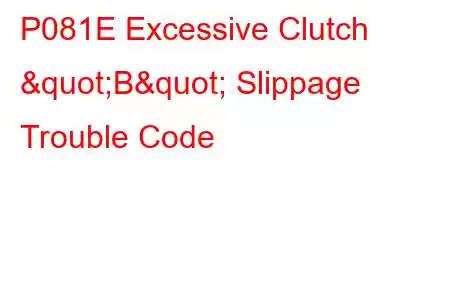P081E Excessive Clutch B Slippage
OBD-II Trouble Code Technical Description
Excessive Clutch B Slippage
What does that mean?
This diagnostic trouble code (DTC) is a generic powertrain code and applies to many OBD-II vehicles (1996-newer). That may include but is not limited to vehicles from Volkswagen, Porsche, Honda, Audi, Acura, etc. Although generic, the exact repair steps may vary depending on year, make, model and powertrain configuration.
If your vehicle has stored a code P081E, it means that the powertrain control module (PCM) has received a data input signal from the input and output speed sensors which indicates that the clutch is slipping excessively. The denotation clutch B indicates that the vehicle is equipped with a clutch (pedal) position sensor (CPPS) which functions similarly to a throttle position sensor (TPS).
The transmission control module (TCM) may be a stand alone unit but is most commonly integrated into a single housing with the engine control module (ECM). This is called the PCM.
The PCM utilizes input signals from multiple engine and transmission sensors to calculate the maximum allowable degree of transmission (clutch) slippage. Clutch disc and pressure plate wear, as well as mechanical failure, may lead to excessive clutch slippage. Discrepancies in CPPS voltage may also result in a P081E being stored. The PCM uses voltage input signals from the transmission input speed sensor and transmission output speed sensor, as well as the position of the clutch pedal, to determine if the clutch is functioning within the parameters for maximum allowable slippage.
Often when the friction material on the clutch disc is worn down below a certain level, the clutch begins to slip. This condition is usually accompanied by the distinctive odor of burnt friction material.
If the PCM detects a degree of transmission (clutch) slippage that exceeds maximum allowable parameters, a code P081E may be stored and a malfunction indicator lamp (MIL) illuminated. Multiple ignition cycles (with a failure) may be required for MIL illumination.
What is the severity of this DTC?
A stored code P081E indicates that either a serious electrical issue or some type of clutch failure has occurred. At any rate, conditions which contributed to a code of this nature being stored should be rectified as quickly as possible.
What are some of the symptoms of the code?
Symptoms of a P081E trouble code may include:
Transmission slippage Harsh gear engagement Clutch engagement occurs near the top Strong odor of burnt friction materialWhat are some of the common causes of the code?
Causes for this code may include:
Bad CPPS sensor Worn clutch disc and/or pressure plate Defective input or output speed sensor Shorted wiring for input speed/output speed sensors Faulty PCM or a programming errorWhat are some P081E troubleshooting steps?
Before attempting to diagnose a P081E, make sure that the clutch, pressure plate, and throwout bearing are functioning properly. You will also want to check clutch arms and bushings as well as clutch hydraulics if applicable.
A diagnostic scanner, a digital volt/ohmmeter (DVOM), and a source of vehicle specific diagnostic information will be required to diagnose a code P081E. An oscilloscope may also be helpful when attempting to diagnose input and output speed sensor malfunctions. CPPS output voltage can also be monitored using the DVOM or oscilloscope. The latter is more effective for the detection of voltage spikes and glitches.
You may use your source of vehicle information to locate a technical service bulletin (TSB) that matches the vehicle year, make, and model; as well as the engine size, code/s stored, and symptoms exhibited. If you find one, it could yield helpful diagnostic information.
With the clutch functioning properly,
Read: 23


